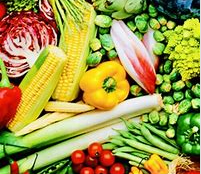School Garden Specific Produce Safety
Phil Tocco, MSU Extension Educator

Working in school gardens can be the highlight of a child’s day in school. How the child works with the garden can have a profound impact on the safety of the produce when they consume it. Nobody wants to get a bad case of diarrhea, or worse, from eating school garden produce. Here are a few things to consider when working with children in a school garden.
Clean Healthy Kids
The fruits and vegetables being grown in the garden are food. Just as kids should wash their hands before eating or cooking, they should wash their hands before harvesting. Their clothing should be clean as well, in the event the produce they pick touches their clothing. Foodborne illness spreads through bodily fluids. If kids are ill with diarrhea or have been recently feverish or vomiting, they shouldn’t be harvesting produce either. These rules apply to grownups too. Don’t pick when you’re sick.
Keep Poop off Food
Poop from birds, cats, dogs and mice can all make humans sick if they eat it. That means if produce has poop on it, kids shouldn’t pick or touch it. After the kids have left a garden area where produce has poop on it, a grown-up should go through and remove the produce and dispose of it in the trash. It is important not to compost produce that has visible poop on it. Even if you are able to wash off the visible part of poop, there are enough bacteria still stuck to the produce to cause a problem. When it comes to poop on produce, don’t pick it and let the grownups handle it. Don’t pick poopy produce.
Keep Food Contact Surfaces Clean
Always remember that what you are harvesting is food. EVERYthing the produce touches should reflect that. Whether it’s buckets, bags or boxes, they really need to be clean enough to eat off of. If you wouldn’t eat a cheeseburger sitting on the dirt, you shouldn’t pick up a tomato that’s dropped to the ground. If you wouldn’t stick your tongue on it, don’t put your produce in or on it.
It’s a bit of a mind shift to think about school garden produce as a potential source of harmful pathogens, but they exist whether we realize they’re there or not. It’s everyone’s job to handle produce in ways that minimize pathogens on food. All these ideas, when effectively and consistently implemented, will not only help to keep the food generated from a school garden safe, but also help teach kids the kind of care professional farmers take with the food sold in the grocery store as well.
